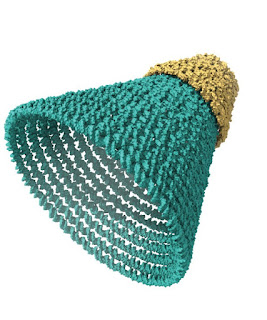Could these be teeny-tiny baskets? My husband Randy pointed out a "tiny rounded object" made of DNA strands in an article by Duke University. These nanoscale structures are from research labs at Duke and Arizona State University.
Described in phys.org and likened to pottery, the objects are made of "threadlike molecules of DNA, bent and folded into complex three-dimensional objects with nanometer precision." These containers are smaller than two millionth of an inch! Such an unfathomable number, wherein more than 50,000 could fit on a pin head. Future uses of such containers could include drug delivery systems, medical imaging, or casting molds for solar cells.
Looking at the photographs in the article, the "threadlike molecules," described as "concentric rings of DNA," appear to me to be more like basketry warps and less like pottery vessels. But that's my opinion, and I see baskets everywhere.
I
Images: Raghu Pradeep Narayanan and Abhay Prasad, Yan lab, Arizona State University.
Read the article here:
Software lets researchers create tiny rounded objects out of DNA. Here's why that's cool
by Duke University. December 23. 2022
https://phys.org/news/2022-12-software-tiny-rounded-dna-cool.html




